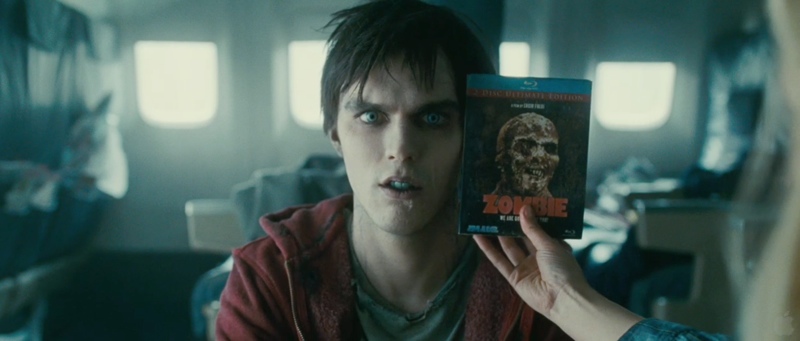2013 // USA // Kirk De Micco and Chris Sanders // March 19, 2013 // Digital Theatrical Projection (Wehrenberg Ronnies 20 Cine)
It’s probably unavoidable that any discussion of Dreamworks Animation’s The Croods will reference Hanna Barbera Productions’ seminal Boomer Era television series The Flintstones. Both are built around a nearly identical high concept: a pointedly anachronistic depiction of a Paleolithic nuclear family. Still, aside from this superficial similarity—and an affection for creaky jokes about a oafish husband’s loathing for his irascible mother-in-law—the two works share little in common. How the The Flintstones ever came to be regarded as a iconic children’s show is still a bit of mystery: It was, at bottom, a retrograde domestic sitcom, and seems to have left an impression on the pop cultural consciousness primarily due to its lame geological puns and dinosaur-appliance sight gags. The Croods, meanwhile, is a fairly straightforward middlebrow comedy adventure feature. As with Dreamworks’ previous theatrical film, The Rise of the Guardians, its visual design is undeniably wondrous, but The Croods is ultimately undermined by a bland and muddled story.
That story concerns Eep Crood (Emma Stone), a wily adolescent cavegirl who scurries across the prehistoric landscape like a bubbly, unstoppable bobcat. Eep dwells in a cave with her overprotective father Grug (Nicholas Cage), doting mother Ugga (Catherine Keener), dimwitted younger brother Thunk (Clarke Duke), baby sister Sandy (Randy Thom), and salty old Gran (Cloris Leachman). As Eep explains in a animated cave-painting prologue, her clan has outlived their less fortunate Stone Age neighbors by following Grug’s fearful rules to the letter. Those rules entail pummeling potential food sources with rocks, fleeing in terror from anything unusual, and cowering in fear in their hidey-hole after dark. Naturally, Eep chafes under her father’s watchful eye, longing for something more meaningful than mere scrabbling survival.
During an illicit nocturnal foray from the family den, Eep runs headlong into nerdy-yet-hunky solitary caveboy Guy (Ryan Reynolds), who is quite advanced compared to the Croods, what with his “shoes” and “fire”. The anxious Guy claims that the known world is on the brink of a cataclysm, and before long he is alternately following and leading the family towards the fabled land of Tomorrow, which will allegedly offer sanctuary from the looming apocalypse. This, of course, does not sit well with the prideful and reactionary Grug, who until now has managed to keep his little tribe safe from the Paleolithic’s myriad terrors by staying put and doing exactly same thing every day.
Inasmuch as The Croods has a fundamental conflict, it is the tug-of-war between Eep’s yearning for fresh experiences on the one hand, and Grug’s paternal compulsion to keep his family out of harm’s way on the other. It’s not exactly an original hook for a story, and the fuzziness of Eep’s longing just draws attention to how much her character resembles a generic sketch of every Disney protagonist ever. Compared to the emotional elegance and complexity of the parent-child relationship depicted in last year’s Brave, the Eep-Grug antagonism is crude, sitcom-level stuff. There is even a wincingly unfunny scene in which Grug haplessly attempts to ape Guy’s cerebral ways, in a variation on a hackneyed “Dad tries to be cool” sequence.
Still, there’s something appealingly geeky about the way that The Croods frames the generation gap within a cartoon prehistory context. In the same way that Dreamworks’ How to Train Your Dragon can be viewed as a myth about the domestication of animals, The Croods is a cockeyed, allegorical take on the triumph of Homo sapiens sapiens in a hostile world. It’s utterly ahistorical and not developed with any seriousness, but the theme of emergence from benighted, animalistic terror into the realm of language, culture, and creativity is always close at hand, even when the film is otherwise preoccupied with wacky critters and slapstick hijinks.
Despite such glimmers of intriguing potential, the screenplay by co-directors Kirk De Micco and Chris Sanders is arguably the film’s most glaring weakness. The Croods simply can’t figure out whether Eep or Grug is the Real Hero of the story. Eep is the narrator, and initially the film provides every indication that is a well-worn tale of adolescent rebellion, wherein the plucky teen discovers her potential while also learning that Family Is What Matters. But wait! Somewhere around the 65-minute mark, the film’s primary viewpoint unaccountably and indisputably shifts to Grug, and thereafter the The Croods spends most of its remaining running time establishing the depth of his paternal affection and self-sacrifice. Dual perspectives and storylines aren’t a defeating quality, of course, but The Croods doesn’t resemble a feature that aims to equitably depict the psychological journeys of both father and daughter. It just feels like a film that forgot what the hell it was doing and decided to do something else.
As with most of the more action-oriented Dreamworks films since Kung Fu Panda, the artistry of The Croods’ design is undeniable. The film refrains from doltishly scrambling the paleo-history of Earth—no dinosaurs and cavemen coexisting here—and instead leaps enthusiastically into out-and-out fantasy. The Stone Age landscape that Eep and her family inhabit is not a cartoon version of the past, but rather a wondrous, almost Seuss-like fictional world of twisted terrain and freakish life-forms. Despite the film’s flaws story-wise, it’s damn amazing to look at. The filmmakers pile on bizarre creature, landforms, and natural phenomena with the gusto of veterans who truly appreciate the potential of their digital canvas. The film features some eye-popping use of deep focus, and the anamorphic widescreen has never felt more essential to the studio’s creations than it does here.
Unfortunately, the character designs aren’t as easy on the eyes as they are in Panda, Dragon, or Guardians, and they occasionally veer into outright ugliness or uninspired rejiggering. The feline antagonist that bedevils Eep’s family in the first act draws a bit too strongly from Tarzan’s Sabor—although it has a nifty resemblance to a great horned owl from certain angles. (Similarly, Sandy looks like an exact cross between Pebbles Flintstone and The Incredibles’ Jack-Jack Parr.) It’s Eep that invites a truly conflicted reaction in the viewer. Her triangular silhouette—topped by scarlet Roseanne Roseannadanna hair—is truly arresting, and there’s something quite cool about a teen heroine who boasts a rugby’s player’s body. In certain shots, however, Eep’s features look downright unpleasant, more of a squashed caricature than a character. Then, ten seconds later, she looks for all the world like an adorable Raiders of the Lost Ark-era Karen Allen. It’s terribly disorienting.
The Croods is first and foremost a cartoon action comedy aimed at kids, and it’s packed with all that one expects of that genre in 2013: zany, hyperkinetic set pieces; animals that mug shamelessly for the camera; and copious gags involving characters being brutally smacked around to no lasting injury. It’s effective and inoffensive in this respect, but fairly forgettable. Nimble and modestly fun, certainly, but by the dizzying standards set by The Adventures of Tintin and Dreamworks’ own Panda films, it’s tame, disposable stuff.
The most distracting element to the whole package is Alan Silvestri’s music, which isn’t bad so much as it is schizophrenic. The opening hunt sequence is scored to a strange but attention-grabbing track that’s part half-time march and part Isaac Hayes funk—evoking, of all things, the anonymously groovy action soundtrack of a Quinn Martin television movie circa 1972. Unfortunately, the score tends to switch gears jarringly: first to classical bombast, and then again to saccharine sweep, and then yet again to the manic energy of a Technicolor musical. The score’s sheer unwillingness to settle on a tone—combined with the unfulfilled promise of that early eccentricity—leaves an unfortunately disjointed sensation.










